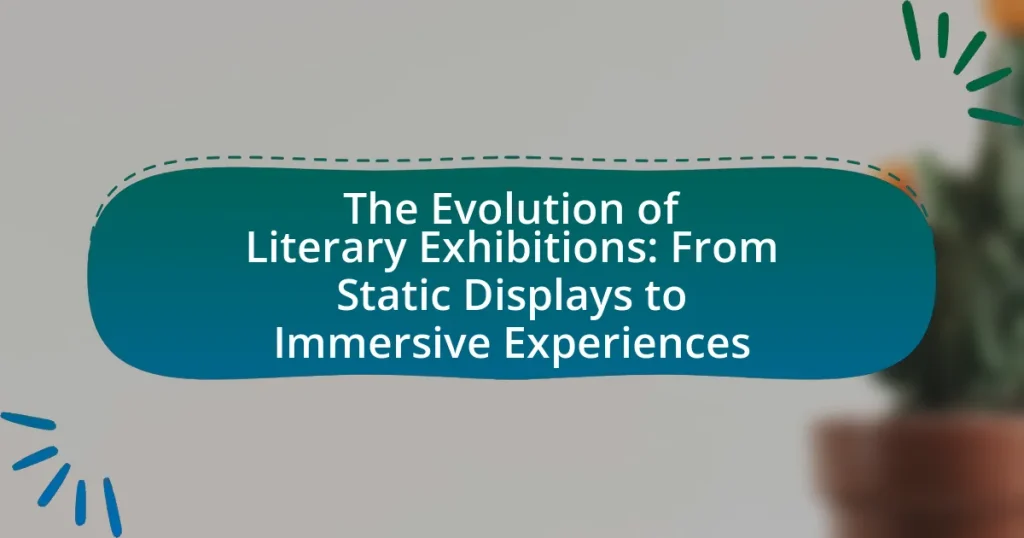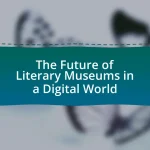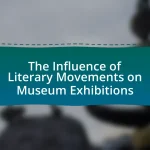Literary exhibitions are curated displays that highlight literary works, authors, and the cultural contexts of literature, evolving significantly since their inception in the 19th century. Initially characterized by static displays of books and manuscripts, these exhibitions have transformed into immersive experiences that utilize technology such as virtual and augmented reality to engage audiences dynamically. The article explores the historical context of literary exhibitions, their evolution over time, the impact of technological advancements, and their role in promoting literature and engaging diverse audiences. It also examines the characteristics of static displays versus immersive experiences, the benefits of each, and future trends in the organization of literary exhibitions.
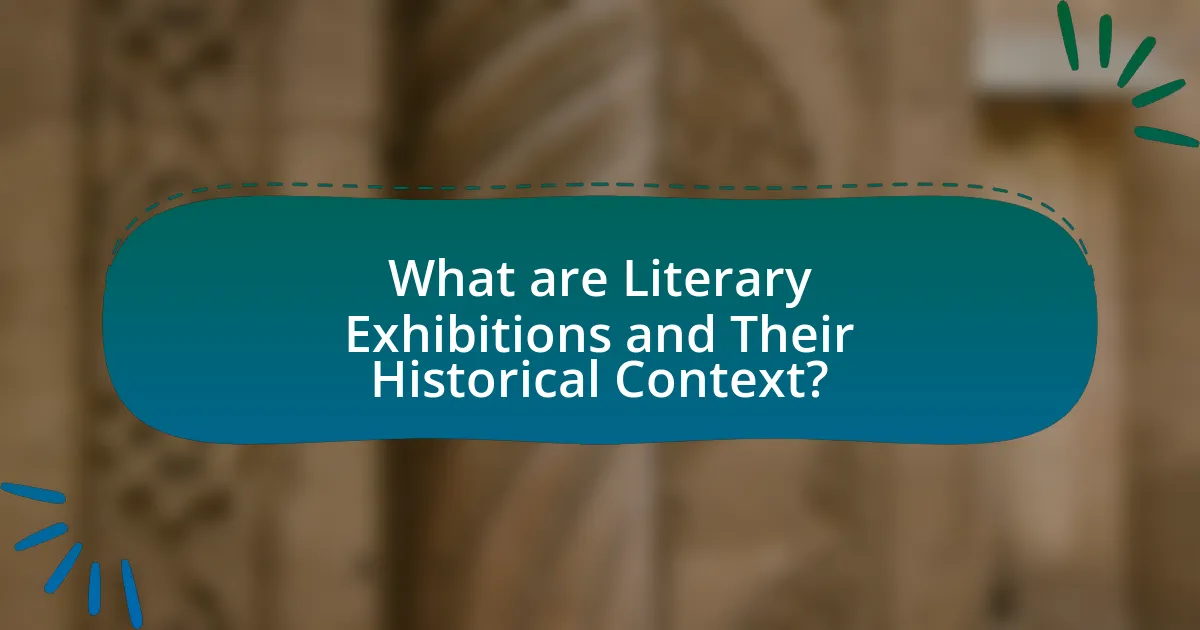
What are Literary Exhibitions and Their Historical Context?
Literary exhibitions are curated displays that showcase literary works, authors, and the cultural context surrounding literature. Historically, these exhibitions emerged in the 19th century, coinciding with the rise of public libraries and the democratization of literature, which allowed broader access to literary texts. Notable examples include the 1934 New York World’s Fair, which featured a significant literary exhibition, and the British Library’s exhibitions that highlight the evolution of written works. These events have evolved from static displays of books and manuscripts to immersive experiences that engage audiences through multimedia presentations and interactive elements, reflecting the changing landscape of literature and its consumption.
How have literary exhibitions evolved over time?
Literary exhibitions have evolved from static displays of books and manuscripts to immersive experiences that engage audiences through interactive technology and multimedia. Initially, literary exhibitions primarily showcased physical texts in libraries and museums, focusing on the preservation and presentation of literary works. Over time, advancements in technology have transformed these exhibitions, incorporating digital elements such as virtual reality, augmented reality, and interactive installations that allow visitors to engage with literature in dynamic ways. For instance, the British Library’s “Harry Potter: A History of Magic” exhibition in 2017 utilized multimedia displays and interactive features to enhance visitor experience, illustrating this shift towards more engaging formats.
What were the characteristics of early literary exhibitions?
Early literary exhibitions were characterized by their focus on static displays of books, manuscripts, and printed materials, often arranged in a manner that emphasized their historical and cultural significance. These exhibitions typically featured limited interactive elements, relying instead on textual descriptions and visual presentations to convey information about the works displayed. The primary goal was to educate the public about literary heritage, showcasing notable authors and significant literary movements. For instance, the first major literary exhibition, the 1851 Great Exhibition in London, included a section dedicated to literature, highlighting the importance of books in society and culture.
How did technological advancements influence literary exhibitions?
Technological advancements significantly transformed literary exhibitions by enabling interactive and immersive experiences. Innovations such as digital displays, augmented reality, and virtual reality have allowed audiences to engage with literary works in dynamic ways, moving beyond traditional static displays. For instance, the use of touchscreen interfaces and multimedia presentations has made it possible for visitors to explore authors’ backgrounds, themes, and historical contexts in depth. Additionally, advancements in printing technology have facilitated the production of high-quality, visually appealing materials that enhance the overall aesthetic of exhibitions. These changes have led to increased visitor engagement and a broader appreciation for literature, as evidenced by the rise in attendance at exhibitions that incorporate these technologies.
What role do literary exhibitions play in promoting literature?
Literary exhibitions play a crucial role in promoting literature by providing a platform for authors, publishers, and literary works to reach a broader audience. These exhibitions facilitate direct engagement between creators and readers, fostering a community around literature. For instance, events like the Frankfurt Book Fair, which attracts over 300,000 visitors annually, showcase diverse literary genres and emerging authors, significantly increasing visibility and sales for participating works. Additionally, literary exhibitions often include panels, readings, and workshops that enhance the educational aspect of literature, encouraging deeper appreciation and understanding among attendees.
How do literary exhibitions engage different audiences?
Literary exhibitions engage different audiences by utilizing interactive elements, multimedia presentations, and thematic storytelling to create immersive experiences. These strategies cater to diverse interests and learning styles, allowing visitors to connect with literature in various ways. For instance, interactive displays encourage participation, while multimedia components, such as video installations and audio readings, appeal to visual and auditory learners. Additionally, thematic storytelling can resonate with specific cultural or historical contexts, drawing in audiences who may have a personal connection to the subject matter. This multifaceted approach has been shown to increase visitor engagement and satisfaction, as evidenced by studies indicating that interactive and immersive experiences significantly enhance audience retention and enjoyment in cultural settings.
What impact do literary exhibitions have on authors and publishers?
Literary exhibitions significantly enhance visibility and networking opportunities for authors and publishers. These events allow authors to showcase their work directly to potential readers and industry professionals, fostering connections that can lead to publishing deals and collaborations. For instance, the Frankfurt Book Fair, one of the largest literary exhibitions, attracts thousands of publishers and authors annually, facilitating over 10,000 business meetings, which underscores the importance of such platforms in the literary ecosystem. Additionally, literary exhibitions often feature panel discussions and workshops that provide authors with insights into market trends and reader preferences, further benefiting their careers and the publishing industry as a whole.
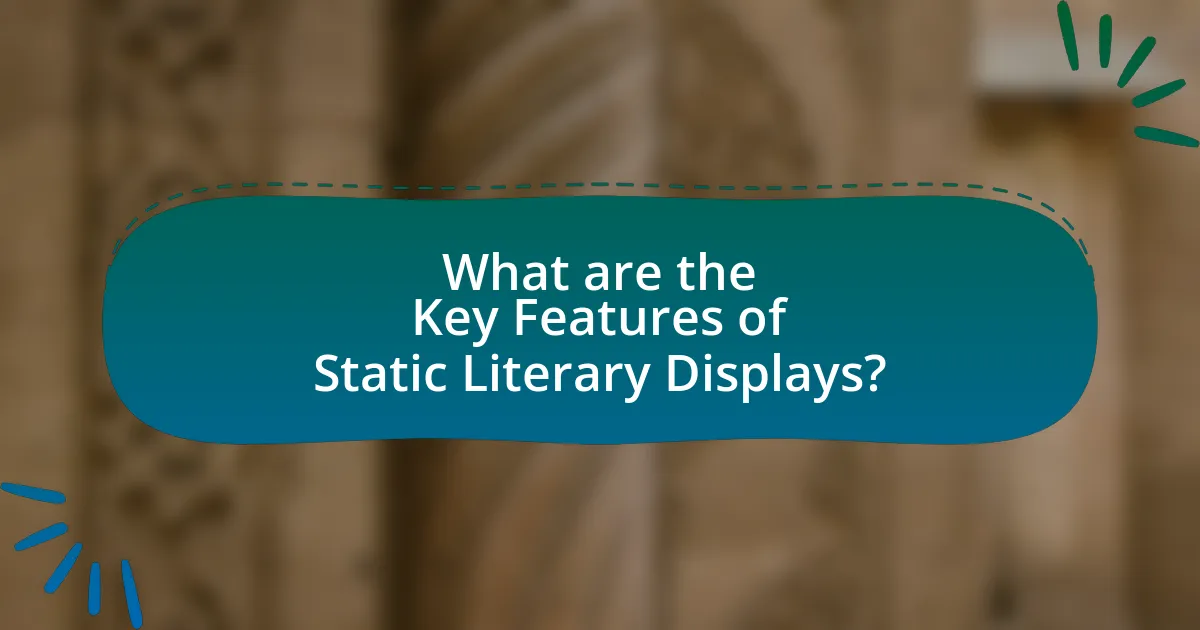
What are the Key Features of Static Literary Displays?
Key features of static literary displays include fixed arrangements of texts, visual elements, and thematic organization. These displays typically present literature in a structured format, often utilizing shelves, cases, or panels to showcase books and related materials. Thematic organization allows for the grouping of works by genre, author, or subject, enhancing the viewer’s understanding of literary contexts. Additionally, static displays often incorporate visual aids such as illustrations, photographs, or artifacts that complement the texts, providing a richer experience. Historical examples, such as library exhibitions or museum displays, demonstrate the effectiveness of these features in engaging audiences and promoting literary appreciation.
How do static displays differ from immersive experiences?
Static displays present information in a fixed format, typically through text, images, or objects that viewers observe without interaction, while immersive experiences engage participants actively, allowing them to interact with the environment and content. Static displays often rely on visual and textual elements to convey messages, whereas immersive experiences utilize technology, sound, and spatial design to create a multi-sensory environment that fosters deeper emotional connections and engagement. Research indicates that immersive experiences can enhance learning and retention by up to 75% compared to traditional static displays, highlighting their effectiveness in engaging audiences.
What are the limitations of static literary displays?
Static literary displays have several limitations, primarily their inability to engage audiences dynamically. These displays often lack interactivity, which can lead to reduced visitor interest and retention of information. Additionally, static formats may not accommodate diverse learning styles, as they typically rely on visual and textual elements without auditory or kinesthetic components. Research indicates that interactive experiences can enhance learning outcomes by up to 75%, highlighting the effectiveness of engagement over passive observation. Furthermore, static displays may not adapt to the evolving context of literary works, limiting their relevance and impact over time.
What elements are commonly found in static literary exhibitions?
Static literary exhibitions commonly feature elements such as displayed manuscripts, printed books, author biographies, thematic panels, and visual art related to the literary works. These components serve to provide context and enhance the understanding of the literature being showcased. For instance, displayed manuscripts often include original drafts or letters that illustrate the author’s creative process, while printed books allow visitors to engage directly with the texts. Author biographies offer insights into the lives and influences of the writers, and thematic panels help to frame the literary works within broader cultural or historical contexts. Visual art, such as illustrations or photographs, complements the literary pieces and enriches the overall experience for attendees.
What are the benefits of static literary displays?
Static literary displays offer several benefits, including enhanced accessibility, focused engagement, and preservation of literary works. These displays allow audiences to interact with texts in a tangible format, making literature more approachable and inviting. For instance, static displays can be strategically placed in libraries or public spaces, ensuring that a diverse audience can access literary materials without the need for technology. Additionally, they encourage focused engagement by presenting curated selections that highlight specific themes or authors, fostering deeper appreciation and understanding of the literature. Furthermore, static displays contribute to the preservation of literary works by providing a stable environment that protects texts from the wear and tear associated with frequent handling, thus maintaining their integrity for future generations.
How do static displays contribute to educational purposes?
Static displays contribute to educational purposes by providing visual and tangible representations of information that enhance learning and retention. These displays facilitate engagement by presenting complex concepts in an accessible format, allowing learners to interact with content in a meaningful way. For instance, studies have shown that visual aids can improve comprehension and recall by up to 65%, as they cater to various learning styles and preferences. Additionally, static displays often include curated information that encourages critical thinking and exploration, making them effective tools in educational settings.
What types of audiences are best served by static displays?
Static displays are best served for audiences seeking informative and educational experiences, such as students, researchers, and casual visitors. These audiences benefit from the clear presentation of information, historical context, and visual engagement that static displays provide. For instance, educational institutions often utilize static displays to enhance learning by presenting curated content that supports curriculum objectives, making it easier for students to absorb knowledge in a structured format. Additionally, museums and libraries frequently employ static displays to attract casual visitors who appreciate visual storytelling and the opportunity to engage with artifacts and literature in a traditional format.
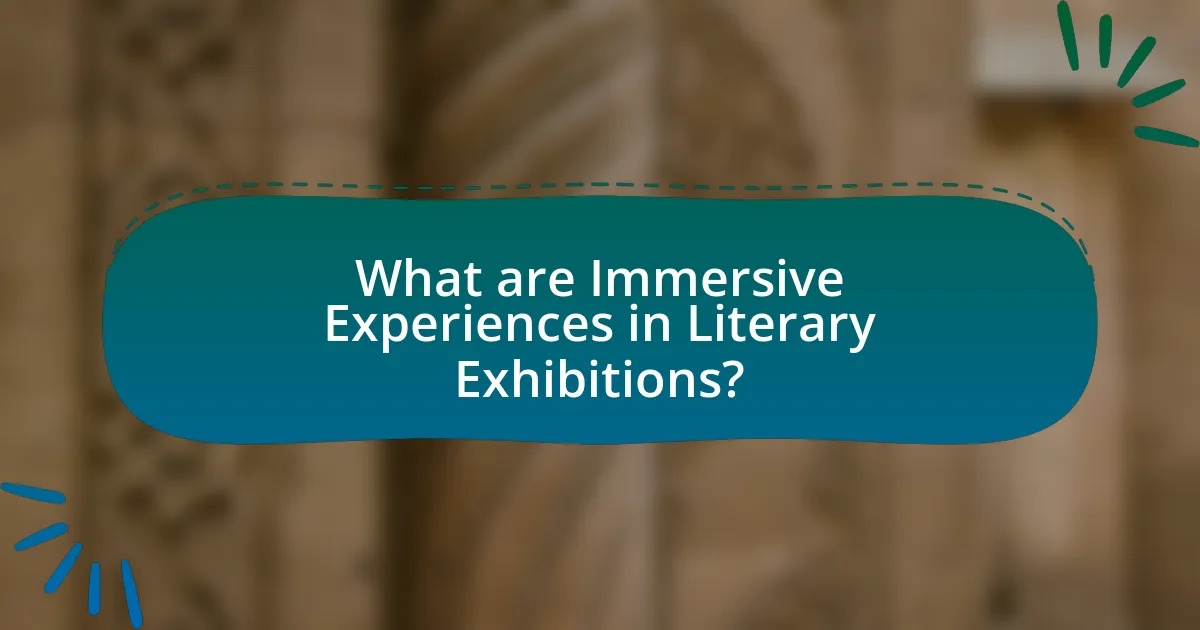
What are Immersive Experiences in Literary Exhibitions?
Immersive experiences in literary exhibitions are interactive and engaging environments that allow visitors to deeply connect with literary works through sensory and participatory elements. These experiences often incorporate technology, such as virtual reality or augmented reality, to create a multi-dimensional exploration of narratives, characters, and themes, enhancing the understanding and appreciation of literature. For instance, exhibitions may feature soundscapes, visual projections, and tactile installations that bring stories to life, allowing audiences to experience literature in a dynamic and memorable way.
How do immersive experiences enhance audience engagement?
Immersive experiences enhance audience engagement by creating interactive environments that stimulate multiple senses, fostering deeper emotional connections. These experiences encourage active participation, which increases retention and understanding of the content presented. For instance, studies have shown that audiences retain 70% of information when they actively engage with it, compared to only 10% when they passively receive information. This heightened engagement is evident in literary exhibitions that incorporate virtual reality or interactive storytelling, allowing visitors to explore narratives in a more personal and impactful way.
What technologies are used to create immersive literary experiences?
Virtual reality (VR), augmented reality (AR), and interactive multimedia are key technologies used to create immersive literary experiences. VR allows users to enter a fully digital environment where they can engage with narratives in a three-dimensional space, enhancing emotional connection and engagement. AR overlays digital content onto the real world, enabling readers to interact with literary elements through their devices, thus blending physical and digital storytelling. Interactive multimedia combines text, audio, video, and animations, providing a dynamic way to experience literature that encourages active participation. These technologies have been successfully implemented in various literary projects, such as the “Alice in Wonderland” VR experience, which immerses users in the story’s fantastical world, demonstrating the effectiveness of these tools in transforming traditional reading into an engaging, multi-sensory experience.
How do immersive experiences change the way literature is perceived?
Immersive experiences significantly alter the perception of literature by engaging multiple senses and creating interactive environments that enhance emotional connection. Traditional literature often relies on static reading, which can limit engagement; however, immersive experiences, such as virtual reality or interactive installations, allow readers to experience narratives in a more dynamic and participatory manner. For instance, studies have shown that participants in immersive literary experiences report higher levels of empathy and emotional involvement, as they can visualize and interact with the story’s context, characters, and settings. This shift from passive consumption to active participation transforms literature into a multi-dimensional experience, making it more relatable and impactful for audiences.
What are some examples of successful immersive literary exhibitions?
Some examples of successful immersive literary exhibitions include “The Enchanted Forest” at the New York Public Library, which transformed the library space into a magical environment inspired by children’s literature, and “The Wizarding World of Harry Potter” at Universal Studios, which offers an interactive experience based on J.K. Rowling’s series. Additionally, “The Great Gatsby” exhibition at the F. Scott Fitzgerald Museum in Maryland utilized multimedia elements to bring the 1920s to life, engaging visitors with the era’s literature and culture. These exhibitions effectively combine literature with immersive environments, enhancing visitor engagement and understanding of the literary works.
What innovative techniques were used in these exhibitions?
Innovative techniques used in literary exhibitions include augmented reality (AR), interactive installations, and multimedia storytelling. Augmented reality enhances visitor engagement by overlaying digital content onto physical displays, allowing for a more immersive experience. Interactive installations invite visitors to participate actively, such as through touchscreens or live performances, fostering a deeper connection with the material. Multimedia storytelling combines text, audio, and visual elements to create a narrative that captivates audiences, making the literary works more accessible and engaging. These techniques reflect a shift from traditional static displays to dynamic, participatory experiences that enhance the appreciation of literature.
How did these exhibitions impact visitor experiences and feedback?
Exhibitions that evolved from static displays to immersive experiences significantly enhanced visitor engagement and satisfaction. This transformation led to increased interactivity, allowing visitors to participate actively rather than passively observe, which resulted in more memorable experiences. For instance, studies have shown that immersive environments can boost visitor retention of information by up to 70%, compared to traditional displays. Feedback from attendees often highlights a greater emotional connection to the content, with many expressing that the immersive elements made the literary themes more relatable and impactful. This shift not only improved overall visitor enjoyment but also encouraged repeat visits and positive word-of-mouth, demonstrating a clear correlation between exhibition design and visitor feedback.
What are the Future Trends in Literary Exhibitions?
Future trends in literary exhibitions include the integration of technology, such as virtual reality and augmented reality, to create immersive experiences for visitors. These advancements allow audiences to engage with literary works in interactive ways, enhancing their understanding and appreciation. For instance, exhibitions may feature digital storytelling elements that bring texts to life, as seen in recent events where VR technology has been used to recreate historical literary settings. Additionally, there is a growing emphasis on inclusivity and diversity, showcasing a wider range of voices and narratives, which reflects contemporary societal values. This trend is supported by initiatives that aim to represent underrepresented authors and genres, thereby broadening the scope of literary exhibitions.
How might technology further transform literary exhibitions?
Technology might further transform literary exhibitions by integrating augmented reality (AR) and virtual reality (VR) to create immersive storytelling experiences. These technologies allow visitors to engage with literary works in dynamic ways, such as visualizing scenes from books or interacting with characters in a virtual environment. For instance, AR applications can overlay digital content onto physical displays, enhancing the narrative context of literary pieces. Additionally, VR can transport users into the settings of novels, providing a deeper emotional connection to the material. Research indicates that immersive experiences can increase retention and understanding of literary themes, as evidenced by studies showing that participants in VR environments demonstrate improved comprehension of complex narratives compared to traditional reading methods.
What role will virtual and augmented reality play in future exhibitions?
Virtual and augmented reality will significantly enhance future exhibitions by creating immersive experiences that engage audiences more deeply than traditional displays. These technologies allow for interactive storytelling, enabling visitors to explore literary works in dynamic environments that reflect the narratives and themes of the content. For instance, a study by the University of Southern California found that immersive experiences can increase retention of information by up to 75%, demonstrating the effectiveness of VR and AR in educational contexts. As a result, future exhibitions will likely prioritize these technologies to foster greater emotional connections and understanding of literary works.
What Best Practices Should Be Considered for Organizing Literary Exhibitions?
Best practices for organizing literary exhibitions include thorough planning, audience engagement, and effective curation. Thorough planning involves setting clear objectives, timelines, and budgets to ensure the exhibition meets its goals. Audience engagement can be enhanced through interactive elements, such as workshops or author talks, which have been shown to increase visitor participation and satisfaction. Effective curation requires selecting relevant themes and works that resonate with the target audience, supported by research indicating that well-curated exhibitions attract more visitors and foster deeper connections with the material.
How can curators effectively blend static and immersive elements?
Curators can effectively blend static and immersive elements by strategically integrating physical artifacts with interactive technologies. This approach allows visitors to engage with static displays, such as books and manuscripts, while simultaneously experiencing immersive environments that enhance storytelling. For instance, using augmented reality applications can provide additional context to static items, allowing visitors to visualize historical settings or author backgrounds. Research indicates that exhibitions incorporating both static and immersive elements can increase visitor engagement by up to 40%, demonstrating the effectiveness of this blended approach in enhancing the overall experience.
What strategies can enhance visitor interaction and learning?
Interactive technology, such as augmented reality (AR) and virtual reality (VR), can significantly enhance visitor interaction and learning in literary exhibitions. These technologies allow visitors to engage with content in immersive ways, fostering deeper understanding and retention of information. For instance, a study by the University of Illinois found that AR applications in museums increased visitor engagement by 40% and improved knowledge retention by 30%. Additionally, incorporating hands-on activities, such as workshops or interactive storytelling sessions, encourages active participation, making the learning experience more memorable. Research from the Smithsonian Institution indicates that interactive exhibits can lead to a 50% increase in visitor satisfaction and learning outcomes.
